Thirty One is a fast moving game and, due to the simplicity of the rules, can be learned rather quickly by most players. It also goes by a large number of other names such as Scat (which should not be confused with the German trick taking game Skat), Blitz, Clinker, Trenta Et Un, Cadillac and Cad.
The game is designed to be played by two to nine players and uses one standard 52 card deck. Although in this game, there is no real overall relative ranking among the cards in this deck, each card is considered to have a potential point value. The following chart shows the point values for each card in the deck:
| Card | Point Value |
|---|
| 2 to 10 | Face Value Marked on Card |
| Jack, Queen, King | 10 |
| Ace | 11 |
Selection of seating positions and first dealer can be done using a variety of methods, with cutting for high cards from a shuffle deck often the method used. Once determined, the dealer shuffles the cards and offers the deck to the player at his right to cut. After the cut, the dealer then distributes three cards to each player, one by one, face down in a clockwise direction. The dealer then places the remainder of the deck in a face-down pile in the center of the table to form the stock pile. He then turns over the top card of the stock laying it beside the stock pile to start the discard pile. At the start of the game, each player is also provided with three counters or tokens which he should place in front of himself on the table.
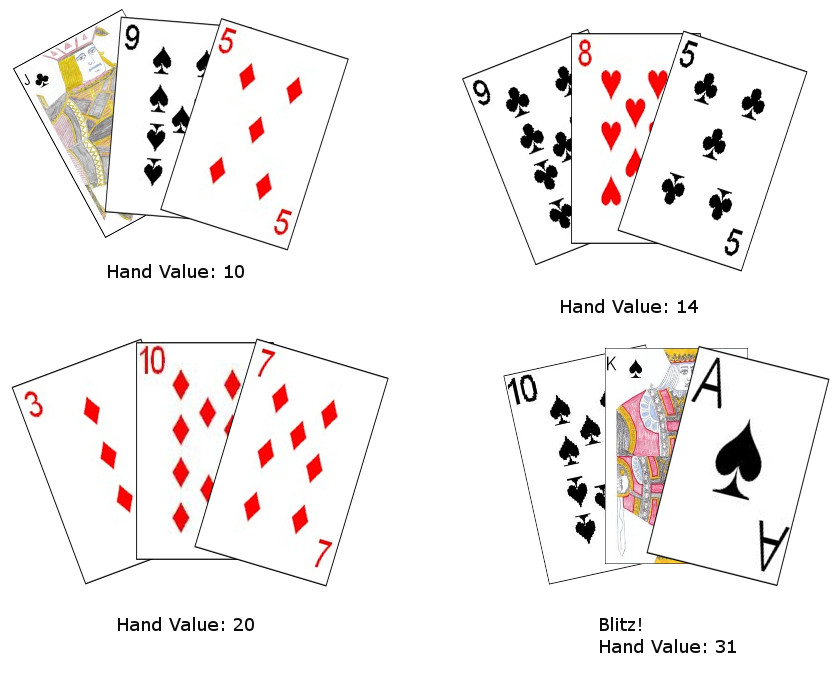
|
| Four sample hands in the game Thirty-One. In the first
illustration, with one card of each suit, the highest card in the hand would determine the value of the hand, in this case the Jack (10). In the second example, the nine and five added together make the highest total, so the total of that hand would be 14. In the third example, since all cards are of the same suit, the total value of the hand would be all three added together. The last hand shows an example Blitz hand, the highest possible total in a player's hand. |
The object of the game is for a player to not be the player or players with the lowest card point total of cards in his hand. As shown in the chart above, each card can contribute a certain point total to a players hand. A player's point count for his hand would be the highest sum of cards of the same suit in his hand. If each of the three cards in a player's hand were of a different suit, his total would be the rank of the highest card in hand. In the case in which two or more players tie with the highest value, the hand with the highest individual card making up this sum would be considered higher. If the high card is also tied, the next highest card comprising the sum would be considered and so on. If all cards are tied, the
tying player closest to the dealer would be considered to have the higher hand.
Play begins with the player to the immediate left of the dealer. Each player has the option of one of three actions he can perform during his turn.
- Knocking
: If a player believes his current count of his hand is higher than that of at least one other current player in the game, he may knock. He does this by simply saying "Knock" or rapping his knuckles on the table in a knocking motion. When a player does this, each remaining player has one final turn to attempt to discard and draw to improve his hand. However, the players are not required to draw a card and may simply pass on this last turn if they prefer to retain the cards in hand. After this occurs, all the hands are revealed to determine the hand winner. The player with the lowest point count found in his hand loses one of his three tokens, which is set aside and no longer used during the current game. If two or more players tie for the lowest score and none are the original knocker for this hand, each of these players loses one token. However, if multiple players tie for lowest score and one player is the knocker, the knocker does not lose a token but the other tied players lose one token. If the knocker has the lowest count after his knock, he loses two tokens instead of just one.
- Draw top discard
: A player on his turn may elect to draw the top, exposed card from the discard pile. After doing so, he would discard any card of his choice from his hand except for the card just drawn from the discard pile.
- Draw from stock
: A player could also opt to draw the top card of the stock pile, adding it to his hand. After drawing this card, the player would then discard any card of his choice to the top of the discard pile.
If a player at any time during the hand (before another player has knocked), finds the point total in his hand to be exactly 31, he calls Blitz and immediately ends the hand. All other players then lose one token.
If the last card of the stock pile is drawn before any player has knocked or managed to collect a Blitz, the round ends in a draw, with no players losing a token for the round.
A player who loses his last token is entitled to continue playing until they would normally be required to lose another token (called a free ride). At this point, that player must then drop from the game. The game continues until there is just one player remaining in the game who is declared the winner.
Three of a Kind: Some players prefer to add the rule that having three cards of the exact same rank (but different suits) counts as 30 points for any player having such a hand. If two players both have the highest total in the game consisting of a three of a kind, the three of a kind of the higher rank is considered the higher.
Schwimmen: Schwimmen is a German variant of Thirty-One. It is played similarly to the standard game with several key differences.
Although the full deck may be used in this variant, it is more often played using a modified 32 card deck. This is a deck made from a standard 52 card deck by removing all cards of denomination 2, 3, 4, 5, and 6. The value of the remaining cards are as in standard Thirty-One.
As in the standard game, each player receives a hand consisting of three cards. In addition, each player receives three tokens or chips which he places on the table in front of himself.
In Schwimmen, after each player has received his regular hand of three cards, three face-up cards are dealt face-down to the center of the table as an extra hand called a widow. The remainder of the stock is set aside. After looking at his hand, the dealer may elect to trade his entire hand with the face-down widow (without looking at the widow). If he elects to do so he takes the three card widow into his hand and replaces it with his entire hand. In either case (whether the dealer traded his cards for the widow or not), the three card widow is then exposed on the table before play of the hand begins.
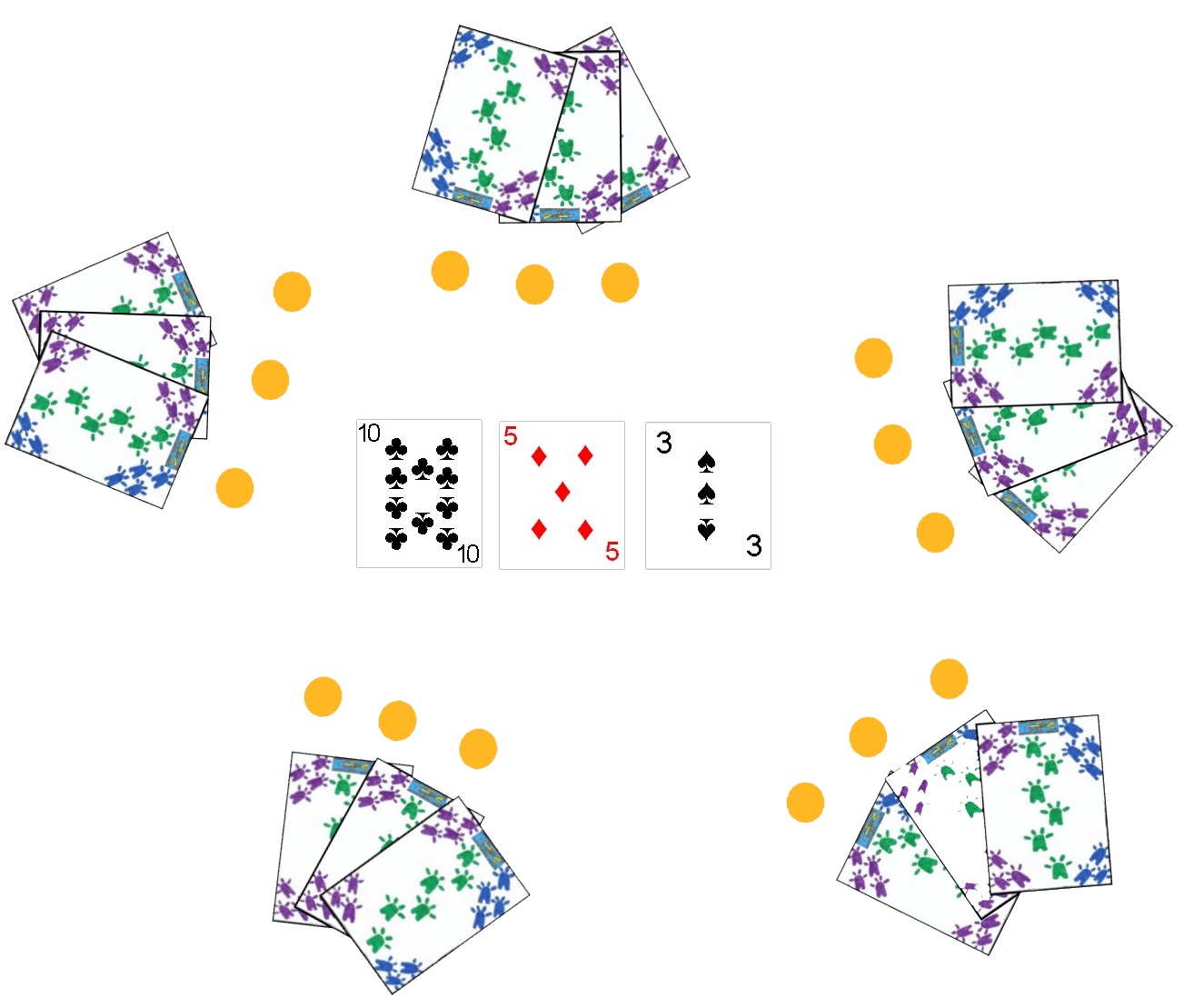
|
| Initial setup for the game Schwimmen including the players tokens, the three card widow in the center, and the player's individual hands. |
After the deal play begins with the player to the dealer's immediate left. Each player on his turn, instead of drawing from the stock pile as in the standard game, may exchange one card from his hand for any card currently in the widow. Alternatively, a player may opt to exchange all three cards from his hand with all three cards in the widow.
Or, finally, a player may elect to pass his turn, exchanging no card from his with the widow. If there are a number of consecutive passes as players in the game, the dealer then discards the three card widow (out of play) and deals a new three card widow to the middle of the table. Play continues using the new widow. If there are not enough cards remaining in the stock to fully replenish the widow, the hand immediately ends in a draw.
As in standard Thirty-One, the players attempt to obtain the highest sum of cards in hand. This total is determined by the highest sum of cards of the same suit in that players hand.
Play continues in this manner until a player either receives a special hand or a player elects to Knock. If a player manages to arrange his hand such that it consists of exactly three Aces, or his hand consists of three cards of the same suit totaling exactly 31, the hand instantly ends. In the case of having the hand consisting of three Aces, each other player must lose one token. In the case of amassing a total of thirty one, the player with the lowest score loses one token.
A player may knock at the completion of his turn if he believes his hand is a winning hand. Each other player in turn then has one last turn to exchange zero, one or three cards with the widow if they would like. After this the hands are totaled. As mentioned, the total of the hand is the highest sum of a player's hand, adding all cards of the same suit. In addition, a hand consisting of three cards of the exact same rank (regardless of suit) is considered to have a total of 30.5 points (unless the hand consists of three Aces, which are considered to have a total to 32 points).
Once the hand is ended, the player with the lowest total then loses one chip. If two or more hands tie for the lowest score, these hands are further ranked as follows; For two or more three of a kinds, these hands are ranked by ranking of the cards making up the three of a kind with a higher one beating a lower one. For ties involving cards of a summation, the hands are ranked by suit of the cards making up the sum in the following order (from highest to lowest); Clubs, Spades, Hearts, Diamonds. If the tying hands are of the same suit, all tying players for the lowest score lose one token.
If a player loses his last chip, he may still continue in play of further hands (this is called Schwimmen, German for swimming) until required to lose another chip or chips, at which point he must drop from the game. The game continues from hand to hand until only one active player remains, who is declared the winner of the game. If, in the rare case, all the last remaining players all tie for lowest hand, then another hand must be played to determine the final winner.
Stop the Bus: This is a variant of Schwimmen which appears to have originated in England and is quite popular there. The mechanics of the game are identical to standard Schwimmen as described above, however, instead of players attempting to obtain the highest card total, they attempt to form the highest ranking hand.
In addition Stop the Bus is most commonly played using one full standard
52 card deck. The hands are ranked as per the following list, from highest to lowest:
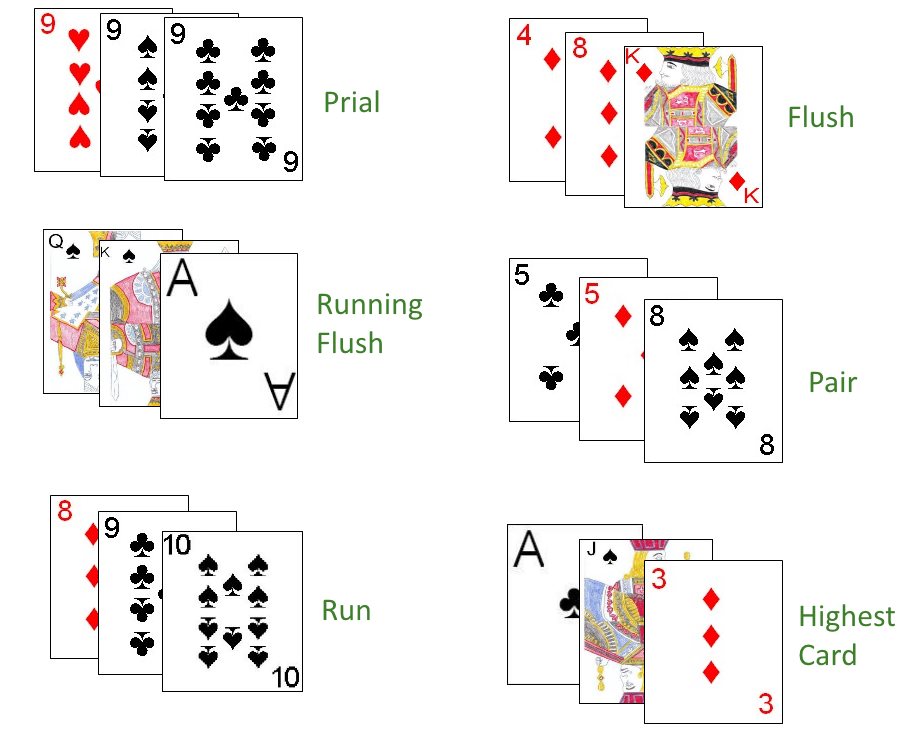
- Prial
- Three cards of the exact same rank. In the event one or
more other players also has a Prial, the Prial of higher ranked cards is
considered a higher ranked hand.
- Running Flush
- Three cards in sequence of the same suit. In the event of multiple players having a running flush, the running flush with the highest top card would be the considered higher. If this is also, equal the players tie for highest and no score occurs on the hand.
- Run
- Three cards in sequence but not all of the same suit. If two or more players have runs, the run with the highest top card is considered higher ranked. If both runs have the same highest top card, the hand is considered a draw and no scoring occurs for the hand.
- Flush
- Three cards of the same suit, not in sequence. If two or more players have Flushes, the highest card in the flush would be compared to determine the highest. If the highest card ties, the next highest, and so on. If all cards are tied, the hand would be considered a tie and no score occurs for the hand.
- Pair
- Two cards of the same rank, with any other third card. If multiple players have such a pair, the pair consisting of the highest cards is considered the highest. If the highest pair is tied, the rank of the third card in the hand is compared. If this card is also tied, the hand is a tie and no score occurs for the hand.
- Highest Card
- The highest card in a players hand. When comparing hands for highest card, if the highest card is tied amongst multiple players, the next highest card would be compared, continuing to the lowest card. If all three cards are of the same denomination for the highest ranking players, the hand is considered a tie and no score occurs on the hand.
In all other aspects this game is played identically to Schwimmen.
No Elimination Thirty-One: Another variant of Thirty-One sometimes played is one in which no tokens are used and players are never eliminated from the game. Instead, points are accrued by certain players at the end of the hand. The following chart shows the possible scores during a hand:
| Scoring Category | Description | Scoring Value (Knocker) | Scoring Value (Player other than Knocker) |
|---|
| Blitz | The Knocker or another player getting a count of exactly 31 | 6 | 6 |
| Highest Total | Player holding the highest card total at the end of a hand | 3 | 4 |
| Middle Totals | Any player's score is not the highest or the lowest | 1 | 2 |
| Lowest Total | Player having the lowest card total at the end of a hand | 0 | 1 |
As will be noted from the chart, multiple players will score on each hand. In the event of tied counts, all tying players are allotted the scoring category which provides them the highest score on the hand.
After a set amount of time or number of hands, the player with the highest total accumulated score over the session is declared the game winner. In all other aspects this variant is played identically to the standard game.
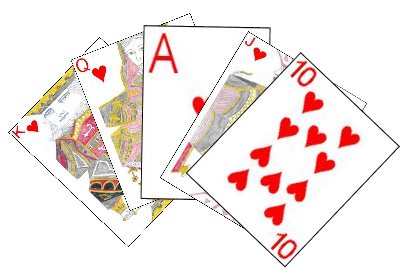 51
51: 51 or Fifty-One is an Asian game which is played very similarly to Thirty-One, but consists of five card hands. There are actually two major variants of 51, one common in Japan and the other common in China, which are both described in detail below.
-
Japanese Fifty One: This version, called Goju Ichi in Japanese, is a popular family and
children's game in Japan. The object of 51 is to obtain a hand consisting of cards in the same suit that total as close to 51 as possible. Each player is dealt 5 cards to begin the game. The dealer then places the next five cards from the top of the stock face-up on the table. He then places the remainder of the stock face-down near the center of the table.
Each player on his turn takes one face-up card from the five on the table, replacing it with any other card from his hand. Starting with a player's second turn, if a player does not want to exchange with any cards on the table, he may Clear the Board. To do this, the player places all five cards that are currently on the table and sets them aside face-down, not be used again in the current hand. He then replaces these five cards with the top five cards from the stock. He must then perform his normal turn, trading one card from his hand with the five new cards on the table. A player may not clear the table on his first turn of the hand, but may on any of his other turns. If the stock runs out or does not have enough cards remaining to replenish the cards cleared from the table, all the cards set aside from previous table clears are shuffled together to form a new stock.
If, after taking his turn a player is satisfied with his hand and believes it might be the highest amongst all the players, may also choose to declare "Stop". When doing this, each other player has one more turn to attempt to improve their hand. After the other player's have each had one last turn, the hands are scored to determine who might have the highest hand.
A player's score is determined by adding the values of all cards from one specific suit and subtracting from that score all cards of other suits from the hand. The player with the highest total wins the hand. If two players tie for the highest score and one is the player who declared "Stop", the non Stopping player wins the hand. If the tie for highest is amongst players other than the player who declared "Stop", these players are all considered to have the highest score and win the hand. The point value for each card, for purposes of determining the point value is the same as in standard Thirty-One; Aces = 11, face cards 10 each, and all other cards the numerical value printed on the card.
- Chinese Fifty One: A similar version of 51 is also played in China, which also uses 5 card hands. In this variant, however, the turns occur in a counter-clockwise direction around the table.
In addition, the deal is performed in the traditional Chinese style, as follows. Any player thoroughly shuffles the deck, placing it face-down in the center of the table. The player to his right then draws the top card from the stock into his hand. Each additional player in a counter-clockwise rotation then also draws a card to start his hand. This continues in rotation around the table until each player has a hand consisting of exactly five cards. The player who drew the first card should then draw one additional card, to obtain a six card hand.
As the first player to draw has one extra card in his hand, he discards one card of his choice from his hand, placing it face-up next to the stock pile. After this, the player to his immediate right has the first turn.
On his turn, each player may do one of the following:
- Draw from the Stock
: A player may draw the top card from the face-down stock pile. He then discards any one card of his choice onto the table, near any previous face-up cards already on the table. If before discarding, the player finds that there are five cards currently face-up, he must remove all those cards, setting them aside, out of play, afterwards making his normal discard to the table.
- Card Trade
: A player may take all cards currently found face-up on the table, and replace them with an equal number of cards from his hand. He may not discard any cards that he just picked up from the table.
- One Card Swap
: If the table has exactly five face-up cards, a player may discard one card from his hand to the table, trading for any one of the face-up cards already on the table.
- Knock
: If a player believes he may have the best hand, he may elect to knock. This ends the hand immediately and the hands are compared and scored. When this occurs, the Caller places his hand face-down on the table and gives any other players, in turn, the opportunity to challenge his call. If no players challenge the Call, the Caller exposes his hand and scores for the total value of his hand. However, if any player challenges the caller, the Callers' and Challengers' hands must be compared. After all players have had the opportunity to Challenge, the Callers' and all Challengers' hands are exposed on the table and compared. If there is exactly one Challenger and the caller's hand is of a higher total then that Challenger, the Caller scores the total value of that Challenger's hand as well as the total of his own hand, with the Challenger scoring 0 and non-challenging players scoring the current value of their own hand. However, if there is exactly one Challenger and the Challengers hand is equal or higher than the Callers hand, the Caller scores 0 and the Challenger scores the total value of the Caller's hand and his own hand, with the non-challenging player scoring the normal value of their own hand. If there are multiple Challengers, the Caller and all the Challengers' hands are exposed. If the Challenger has the highest total of all these hands, he scores the total of all the Challengers' hands plus the total of his own hand. All non-challengers score for the total of their own hand. If one or more of the Challengers' hands score higher than the Caller, the Challenger with the highest total scores the total of the Callers' and all the Challengers' hands summed together (including the value of his own hand). All other Challengers and the Caller score 0. If two or more Challengers tie for the highest score, the last player to Challenge scores the sum of all the Challengers' hands (including
his own) as well as the Caller, and the Caller and the other Challengers score 0 for the hand. All other players score the current total of their own hand.
As in the standard game of Thirty-One, a players hand total is the total sum of all card denominations of cards in one suit. As in Thirty-One, the values of the cards for determination of the total score is as follows; Aces are 11, face cards 10, each other card is the value marked on the card.
While a player usually may not Knock and perform another action on a turn, if a player finds that he has a score of exactly 51 in his hand, he may knock at the end of his turn, which also immediately terminates play. Also, if the stock pile becomes exhausted the hand immediately ends and the hands compared and scored.
If a player has a hand consisting of exactly 51 points, this is called a clear count, and the player scores double for the hand (102 points). Any other players who have hands consisting of all five cards of the same suit score the total value of the hand. Any other players score 0 on the hand.
The game continues until one or more player ends a hand with an accumulated score of 500 or more. At that point the game ends and the player with the highest total score is declared the game winner. If two or more players are tied for the highest score, another hand should be played to determine a winner.
Empat Satu: Empat Satu, also called 41 (or Forty-One) is a game played similarly to the other similar games described on this page, however in this game, players strive to obtain a point total of 41 in hand. This game is originally from Indonesia, but is commonly played in other locales as well.
This game uses one standard 52 card deck and is designed to be played by 2 to 8 players, but is best with 2 to 4. As in other games of this type, each card in the deck has a specific counting point value, as follows:
| Card | Point Value |
|---|
| 2, 3, 4, 5, 6, 7, 8, 9, 10 | Face Value Marked on Card |
| Jack, Queen, King | 10 |
| Ace | 11 |
Any method can be used to determine seating positions and the first dealer, with drawing for high card a common method. The players would then select seats at the table in
the order of cards drawn, from highest to lowest. The player drawing the highest card of all is set as the first dealer. After the first hand, the losing player deals the next hand. Also, on the first hand the dealer has the first turn, on subsequent hands, the winner of the previous hand plays first.
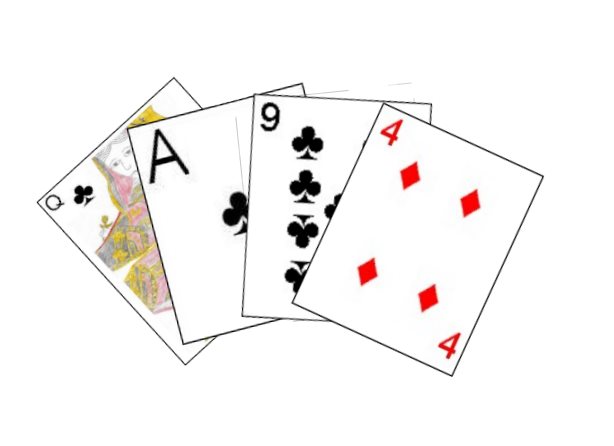
|
| This hand would be
worth 26 points, 30 points for the four cards in the suit of Clubs added
together, and 4 subtracted for the one card of the off suit. |
Once the dealer has been determined, he thoroughly shuffles the deck and passes it to the player at his right to cut. After the cut, the dealer begins dealing in a clockwise direction starting with the player at his immediate left. He deals the cards one at a time and face down, continuing until each player has a total of four cards. After this, the dealer places the remainder of the deck face-down in the center of the table as a stock pile.
Each turn consists of a player drawing the top face-down card of the stock or the top face-up card in the discard pile. On the very first turn of the hand, since there is no discard pile yet, the player must draw from the stock pile. On every subsequent turn, a player may elect to instead take the top card from the discard pile into his hand. A player's turn ends with a discard to the top of the discard pile. A player may never take the top card of the discard pile and discard that same card on that same turn.
If a player, at the start of his turn, before drawing, has all four cards of the same suit in his hand, he may optionally elect to call
"Stop", which ends the hand immediately. A player is never required to call
"Stop" but has that option before beginning his turn. A player may not do this after his draw, but can on his next turn, before drawing. Once a player calls
"Stop", all players expose their hands for scoring. A player's score on the hand is the sum total of all cards in one suit (of the player's choosing) from that hand, subtracted from the sum total of cards from all other suits in the hand. The point values are as listed in the chart above. The player with the highest score, calculated in this manner is declared the winner and the player with the lowest score is the loser of the game. If two or more players tie for the same score, the winner amongst those players can be determined by the lowest card of the positive suit in the hands (the player whose lowest card in the suit in which they have elected to generate positive points is higher of these cards is considered higher than the other such hand of the same point value).
If the stock runs out, the game can continue as long as the next player in turn elects to take the top card of the discard pile (discarding a different card from his hand). At any time a player refuses to take the top card of the discard pile (and the stock pile has been depleted), the hand also ends and the scores totaled as if a player had declared
"Stop".
Each hand is considered a complete game, and a running score is not usually kept from hand to hand. As mentioned previously, the loser of the hand is required to deal the next hand and the winner of the hand has the first turn in the next hand.
Copyright © 2015
CatsAtCards.com. All rights reserved.



 51: 51 or Fifty-One is an Asian game which is played very similarly to Thirty-One, but consists of five card hands. There are actually two major variants of 51, one common in Japan and the other common in China, which are both described in detail below.
51: 51 or Fifty-One is an Asian game which is played very similarly to Thirty-One, but consists of five card hands. There are actually two major variants of 51, one common in Japan and the other common in China, which are both described in detail below.
